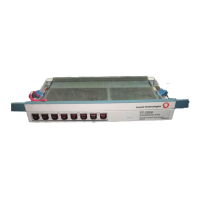Administration and Provisioning
Issue 8.0 July 2002
8-63
■ At node 0, a 1-way drop cross-connection is entered by specifying:
— Source (tributary)
— Source line (line 1E)
— Source STS-3 tributary (tributary 6)
— Source STS-1 tributary (tributary 1)
— Source node TID
*
(node 3 TID)
— Destination (STS-1 port)
— Destination low-speed interface slot
†
(slot 2B)
— Destination low-speed port (1).
NOTE:
While cross-connections are entered, the FT-2000 OC-48 Add/Drop-Rings
Terminal will report several trouble conditions (for example, circuit
provisioning error and path integrity failure). However,
these trouble conditions should be ignored until all the cross-connections
for a circuit have been entered. If the trouble conditions remain after all the
cross-connections have been entered, refer to the "Operation and
Maintenance (TOP)" section (Volume II).
Figure 8-16 shows a worksheet that may be used to record STS-1
cross-connections at FT-2000 OC-48 Add/Drop-Rings Terminals in a 2-fiber
bidirectional ring.
For more information about entering cross-connections at an FT-2000 OC-48
Add/Drop-Rings Terminal, refer to the CIT Tutorial in Volume I, Section 11, "Craft
Interface Terminal Usage," and the Operation Task Index in the "Operation and
Maintenance (TOP)" section (Volume II). For more information about DRI
protection switching, refer to Section 9, "Maintenance Description."
* Entering a question mark (?) in response to the TID prompt will display a point-and-shoot
list of available addresses in the OC-48 ring. Enter the Retrieve-Map-Ring command to
update the point-and-shoot list.
† If the specified slot is part of a slot pair (for example, slot 1A and 1B) that has been
provisioned for the OC-3 1+1 protected mode, specifying one slot also includes the
companion slot. The same type of logic applies to OC-12 1+1 (Release 7.1 and later
releases) protected mode.

